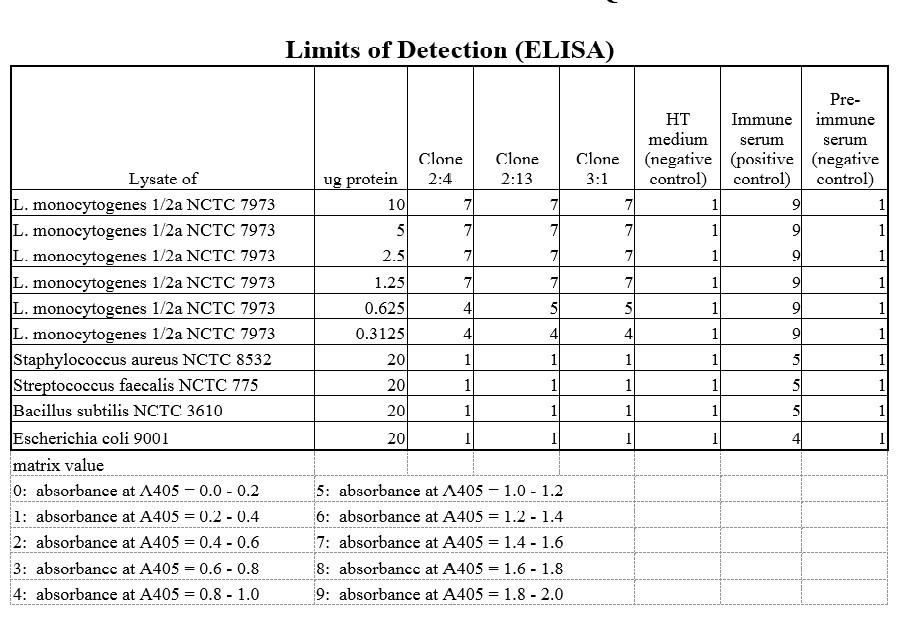Cat. #152799
Anti-Listeria monocytogenes antigen 2 [2:13 C5]
Cat. #: 152799
Unit size: 100 ug
Availability: 3-4 weeks
Target: Listeria monocytogenes antigen 2 protein
Class: Monoclonal
Application: ELISA ; WB
Reactivity: L. monocytogenes
Host: Mouse
£300.00
This fee is applicable only for non-profit organisations. If you are a for-profit organisation or a researcher working on commercially-sponsored academic research, you will need to contact our licensing team for a commercial use license.
Contributor
Inventor: Ayham Alnabulsi
Institute: Vertebrate Antibodies Limited
Tool Details
*FOR RESEARCH USE ONLY (for other uses, please contact the licensing team)
- Name: Anti-Listeria monocytogenes antigen 2 [2:13 C5]
- Alternate name: Listeria monocytogenes
- Research fields: Microbiology
- Clone: 2:13 C5
- Class: Monoclonal
- Conjugation: Unconjugated
- Molecular weight: 74 kDa, (faint) 67 kDa, 68 kDa
- Strain: Balb/c
- Reactivity: L. monocytogenes
- Host: Mouse
- Application: ELISA ; WB
- Description: The genus Listeria comprises six species: L. monocytogenes, L. innocua, L. welshimeri, L. seeligeri, L. ivanovii and L. grayi. Listeria monocytogenes, the most commonly isolated pathogenic member, is associated with a wide spectrum of human and animal diseases. In the smear from the original tissue, L. monocytogenes may appear as gram-positive coccobacilli that may be confused with Streptococcus agalactiae (group B), enterococci, or Corynebacterium spp. Listeria is differentiated from streptococci by a positive catalase test. L. monocytogenes is the only species of the genus Listeria that has been clearly documented as a pathogen for humans. The forms of disease caused by this organism are myriad and age-related. The most common clinical manifestations are meningitis and septicemia. Listeria monocytogenes, a food-borne intracellular animal and human pathogen, interacts with infected host cells both prior to entry and during the intracellular phase of infection.
- Immunogen: Listeria monocytogenes antigen 2 protein
- Isotype: IgG1 kappa
- Myeloma used: P3X63Ag8.653
- Recommended controls: Whole cell lysates of L. monocytogenes
Target Details
- Target: Listeria monocytogenes antigen 2 protein
- Molecular weight: 74 kDa, (faint) 67 kDa, 68 kDa
- Target background: The genus Listeria comprises six species: L. monocytogenes, L. innocua, L. welshimeri, L. seeligeri, L. ivanovii and L. grayi. Listeria monocytogenes, the most commonly isolated pathogenic member, is associated with a wide spectrum of human and animal diseases. In the smear from the original tissue, L. monocytogenes may appear as gram-positive coccobacilli that may be confused with Streptococcus agalactiae (group B), enterococci, or Corynebacterium spp. Listeria is differentiated from streptococci by a positive catalase test. L. monocytogenes is the only species of the genus Listeria that has been clearly documented as a pathogen for humans. The forms of disease caused by this organism are myriad and age-related. The most common clinical manifestations are meningitis and septicemia. Listeria monocytogenes, a food-borne intracellular animal and human pathogen, interacts with infected host cells both prior to entry and during the intracellular phase of infection.
Applications
- Application: ELISA ; WB
Handling
- Format: Liquid
- Concentration: 1 mg/ml
- Unit size: 100 ug
- Storage buffer: PBS with 0.02% azide
- Storage conditions: -15° C to -25° C
- Shipping conditions: Dry ice


![Anti-Listeria monocytogenes antigen 2 [2:13 C5] - Image 2](https://cancertools.org/wp-content/uploads/3cfb7244-d130-4e47-ba82-25f7e3a8ced1.jpg)
![Anti-Listeria monocytogenes antigen 2 [2:13 C5] - Image 2](https://cancertools.org/wp-content/uploads/3cfb7244-d130-4e47-ba82-25f7e3a8ced1-140x140.jpg)

